HRM Report: HRM Practices and Strategies at Brainlabs Company
VerifiedAdded on 2020/01/07
|14
|4323
|139
Report
AI Summary
This report provides a comprehensive analysis of Human Resource Management (HRM) practices within the context of Brainlabs, a UK-based marketing agency. The report begins with a comparison between personnel management and HRM, emphasizing the strategic importance of HRM in achieving organizational objectives. It then delves into the core functions of HRM, including recruitment and selection, employee relations, and training, highlighting the roles and responsibilities of line managers. Furthermore, the report examines the legal and regulatory requirements that HR departments must fulfill, such as the Equal Pay Act and the Health and Safety at Work Act. Task 2 focuses on HR planning, outlining the reasons and stages involved in the process, and comparing recruitment and selection methods. The report also explores motivational theories, reward management, job evaluation, and performance monitoring. Finally, it addresses reasons for termination, exit processes, and the impact of legislation, offering a well-rounded overview of HRM in a practical business setting.

HRM
Paraphrase This Document
Need a fresh take? Get an instant paraphrase of this document with our AI Paraphraser
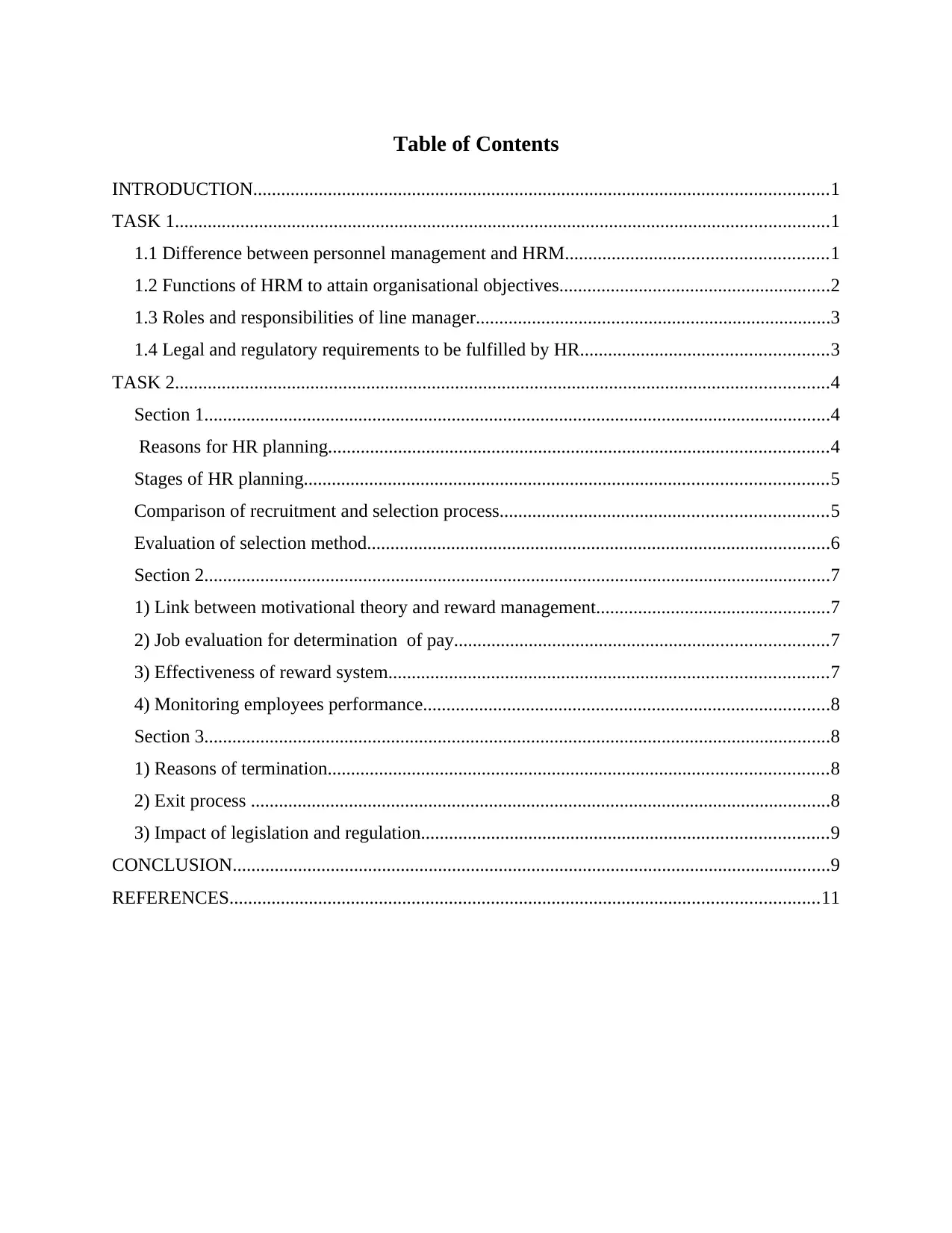
Table of Contents
INTRODUCTION...........................................................................................................................1
TASK 1............................................................................................................................................1
1.1 Difference between personnel management and HRM........................................................1
1.2 Functions of HRM to attain organisational objectives..........................................................2
1.3 Roles and responsibilities of line manager............................................................................3
1.4 Legal and regulatory requirements to be fulfilled by HR.....................................................3
TASK 2............................................................................................................................................4
Section 1......................................................................................................................................4
Reasons for HR planning...........................................................................................................4
Stages of HR planning................................................................................................................5
Comparison of recruitment and selection process......................................................................5
Evaluation of selection method...................................................................................................6
Section 2......................................................................................................................................7
1) Link between motivational theory and reward management..................................................7
2) Job evaluation for determination of pay................................................................................7
3) Effectiveness of reward system..............................................................................................7
4) Monitoring employees performance.......................................................................................8
Section 3......................................................................................................................................8
1) Reasons of termination...........................................................................................................8
2) Exit process ............................................................................................................................8
3) Impact of legislation and regulation.......................................................................................9
CONCLUSION................................................................................................................................9
REFERENCES..............................................................................................................................11
INTRODUCTION...........................................................................................................................1
TASK 1............................................................................................................................................1
1.1 Difference between personnel management and HRM........................................................1
1.2 Functions of HRM to attain organisational objectives..........................................................2
1.3 Roles and responsibilities of line manager............................................................................3
1.4 Legal and regulatory requirements to be fulfilled by HR.....................................................3
TASK 2............................................................................................................................................4
Section 1......................................................................................................................................4
Reasons for HR planning...........................................................................................................4
Stages of HR planning................................................................................................................5
Comparison of recruitment and selection process......................................................................5
Evaluation of selection method...................................................................................................6
Section 2......................................................................................................................................7
1) Link between motivational theory and reward management..................................................7
2) Job evaluation for determination of pay................................................................................7
3) Effectiveness of reward system..............................................................................................7
4) Monitoring employees performance.......................................................................................8
Section 3......................................................................................................................................8
1) Reasons of termination...........................................................................................................8
2) Exit process ............................................................................................................................8
3) Impact of legislation and regulation.......................................................................................9
CONCLUSION................................................................................................................................9
REFERENCES..............................................................................................................................11

⊘ This is a preview!⊘
Do you want full access?
Subscribe today to unlock all pages.

Trusted by 1+ million students worldwide
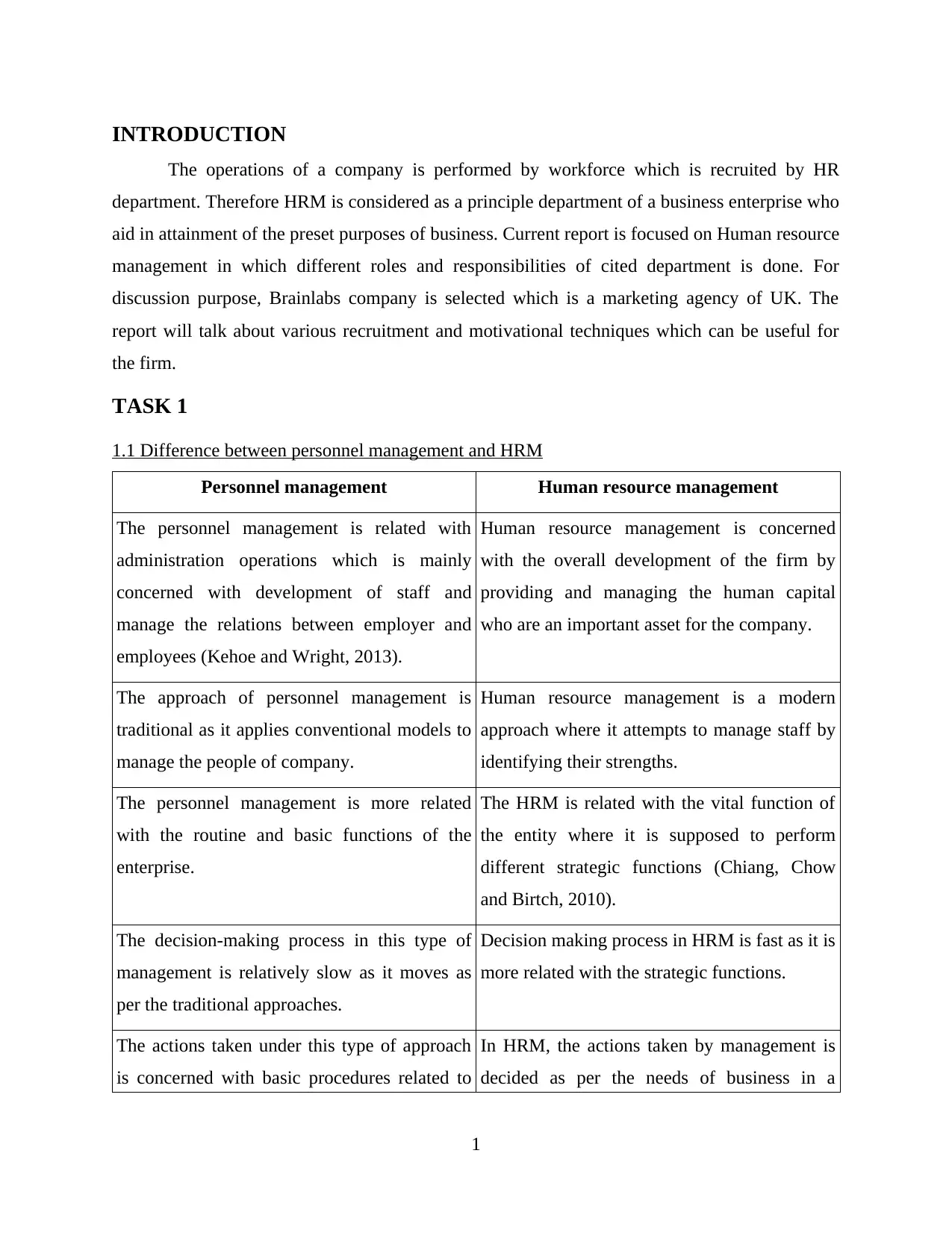
INTRODUCTION
The operations of a company is performed by workforce which is recruited by HR
department. Therefore HRM is considered as a principle department of a business enterprise who
aid in attainment of the preset purposes of business. Current report is focused on Human resource
management in which different roles and responsibilities of cited department is done. For
discussion purpose, Brainlabs company is selected which is a marketing agency of UK. The
report will talk about various recruitment and motivational techniques which can be useful for
the firm.
TASK 1
1.1 Difference between personnel management and HRM
Personnel management Human resource management
The personnel management is related with
administration operations which is mainly
concerned with development of staff and
manage the relations between employer and
employees (Kehoe and Wright, 2013).
Human resource management is concerned
with the overall development of the firm by
providing and managing the human capital
who are an important asset for the company.
The approach of personnel management is
traditional as it applies conventional models to
manage the people of company.
Human resource management is a modern
approach where it attempts to manage staff by
identifying their strengths.
The personnel management is more related
with the routine and basic functions of the
enterprise.
The HRM is related with the vital function of
the entity where it is supposed to perform
different strategic functions (Chiang, Chow
and Birtch, 2010).
The decision-making process in this type of
management is relatively slow as it moves as
per the traditional approaches.
Decision making process in HRM is fast as it is
more related with the strategic functions.
The actions taken under this type of approach
is concerned with basic procedures related to
In HRM, the actions taken by management is
decided as per the needs of business in a
1
The operations of a company is performed by workforce which is recruited by HR
department. Therefore HRM is considered as a principle department of a business enterprise who
aid in attainment of the preset purposes of business. Current report is focused on Human resource
management in which different roles and responsibilities of cited department is done. For
discussion purpose, Brainlabs company is selected which is a marketing agency of UK. The
report will talk about various recruitment and motivational techniques which can be useful for
the firm.
TASK 1
1.1 Difference between personnel management and HRM
Personnel management Human resource management
The personnel management is related with
administration operations which is mainly
concerned with development of staff and
manage the relations between employer and
employees (Kehoe and Wright, 2013).
Human resource management is concerned
with the overall development of the firm by
providing and managing the human capital
who are an important asset for the company.
The approach of personnel management is
traditional as it applies conventional models to
manage the people of company.
Human resource management is a modern
approach where it attempts to manage staff by
identifying their strengths.
The personnel management is more related
with the routine and basic functions of the
enterprise.
The HRM is related with the vital function of
the entity where it is supposed to perform
different strategic functions (Chiang, Chow
and Birtch, 2010).
The decision-making process in this type of
management is relatively slow as it moves as
per the traditional approaches.
Decision making process in HRM is fast as it is
more related with the strategic functions.
The actions taken under this type of approach
is concerned with basic procedures related to
In HRM, the actions taken by management is
decided as per the needs of business in a
1
Paraphrase This Document
Need a fresh take? Get an instant paraphrase of this document with our AI Paraphraser

management (Ployhart and Moliterno, 2011). particular situation.
It takes human capital of organisation as an
ordinary people and concentrates on simple
functions of hiring, making payrolls,
compensations etc.
The HRM assumes all its staff as a valuable
assets that are important for contributing in
firm's success, therefore concentrate on
activities to retain them within organisation
(Nadiri and Tanova, 2010).
As per the above discussion it is clear that both approaches are good but, HRM is more
relevant in the present scenario that should be undertaken by contemporary organisations.
1.2 Functions of HRM to attain organisational objectives
The HRM is concerned with application of various activities within workplace that are
generally aligned with the organisational objectives. All basic to complex functions of the
company are managed as per the norms and policies that are l;aid down by the HR department.
In this sense, a number of functions that are performed by the HRM which helps in attainment
of company's objectives have been encapsulated in the below section:
Recruitment and selection: The most basic and vital function of HRM is to make a
workforce planning by identifying the needs of each department in the firm related to
personnel requirement (Soon and Baines, 2012). Thus, they perform the function of
recruitment and selection of right candidate so that the organisation can have better
outcomes with the help of right personnel having required skills and potential.
Employee relations: Another significant role of HRM is to maintain sound and healthy
relationship between employer and employees. The said department performs various
functions which aids in development of the better environment and positive relationship
between workers and employers. They take initiative to resolve all the conflicts between
various parties so that entire firm cannot be impacted by it in negative way (Lin, Chen
and Chuang, 2011).
Training: The training and development of workers is a vital activity which must be
organised by the enterprises timely. This function is also undertaken by the HRM for
which they use to take the report of employees performance and organise the sessions for
2
It takes human capital of organisation as an
ordinary people and concentrates on simple
functions of hiring, making payrolls,
compensations etc.
The HRM assumes all its staff as a valuable
assets that are important for contributing in
firm's success, therefore concentrate on
activities to retain them within organisation
(Nadiri and Tanova, 2010).
As per the above discussion it is clear that both approaches are good but, HRM is more
relevant in the present scenario that should be undertaken by contemporary organisations.
1.2 Functions of HRM to attain organisational objectives
The HRM is concerned with application of various activities within workplace that are
generally aligned with the organisational objectives. All basic to complex functions of the
company are managed as per the norms and policies that are l;aid down by the HR department.
In this sense, a number of functions that are performed by the HRM which helps in attainment
of company's objectives have been encapsulated in the below section:
Recruitment and selection: The most basic and vital function of HRM is to make a
workforce planning by identifying the needs of each department in the firm related to
personnel requirement (Soon and Baines, 2012). Thus, they perform the function of
recruitment and selection of right candidate so that the organisation can have better
outcomes with the help of right personnel having required skills and potential.
Employee relations: Another significant role of HRM is to maintain sound and healthy
relationship between employer and employees. The said department performs various
functions which aids in development of the better environment and positive relationship
between workers and employers. They take initiative to resolve all the conflicts between
various parties so that entire firm cannot be impacted by it in negative way (Lin, Chen
and Chuang, 2011).
Training: The training and development of workers is a vital activity which must be
organised by the enterprises timely. This function is also undertaken by the HRM for
which they use to take the report of employees performance and organise the sessions for
2
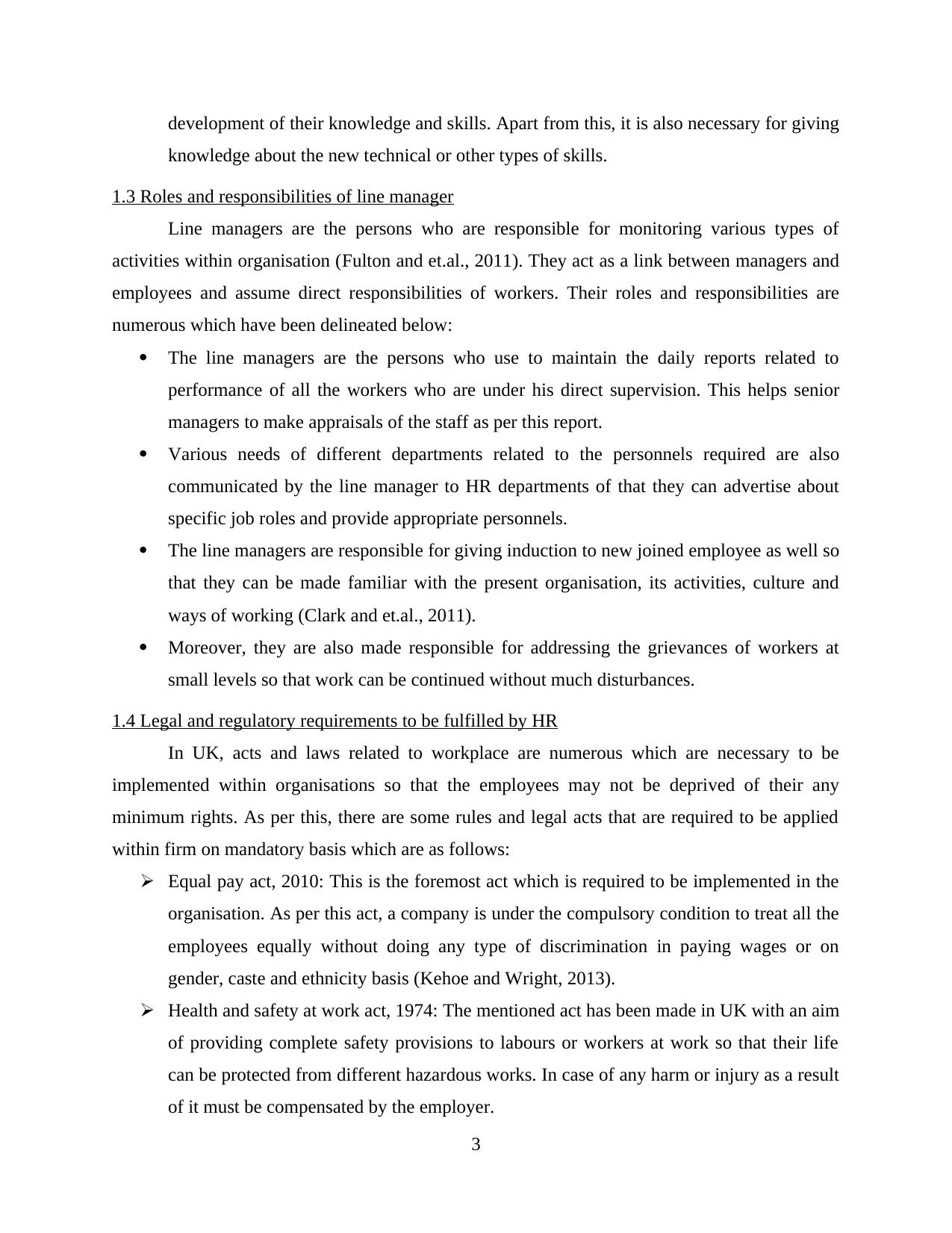
development of their knowledge and skills. Apart from this, it is also necessary for giving
knowledge about the new technical or other types of skills.
1.3 Roles and responsibilities of line manager
Line managers are the persons who are responsible for monitoring various types of
activities within organisation (Fulton and et.al., 2011). They act as a link between managers and
employees and assume direct responsibilities of workers. Their roles and responsibilities are
numerous which have been delineated below:
The line managers are the persons who use to maintain the daily reports related to
performance of all the workers who are under his direct supervision. This helps senior
managers to make appraisals of the staff as per this report.
Various needs of different departments related to the personnels required are also
communicated by the line manager to HR departments of that they can advertise about
specific job roles and provide appropriate personnels.
The line managers are responsible for giving induction to new joined employee as well so
that they can be made familiar with the present organisation, its activities, culture and
ways of working (Clark and et.al., 2011).
Moreover, they are also made responsible for addressing the grievances of workers at
small levels so that work can be continued without much disturbances.
1.4 Legal and regulatory requirements to be fulfilled by HR
In UK, acts and laws related to workplace are numerous which are necessary to be
implemented within organisations so that the employees may not be deprived of their any
minimum rights. As per this, there are some rules and legal acts that are required to be applied
within firm on mandatory basis which are as follows:
Equal pay act, 2010: This is the foremost act which is required to be implemented in the
organisation. As per this act, a company is under the compulsory condition to treat all the
employees equally without doing any type of discrimination in paying wages or on
gender, caste and ethnicity basis (Kehoe and Wright, 2013).
Health and safety at work act, 1974: The mentioned act has been made in UK with an aim
of providing complete safety provisions to labours or workers at work so that their life
can be protected from different hazardous works. In case of any harm or injury as a result
of it must be compensated by the employer.
3
knowledge about the new technical or other types of skills.
1.3 Roles and responsibilities of line manager
Line managers are the persons who are responsible for monitoring various types of
activities within organisation (Fulton and et.al., 2011). They act as a link between managers and
employees and assume direct responsibilities of workers. Their roles and responsibilities are
numerous which have been delineated below:
The line managers are the persons who use to maintain the daily reports related to
performance of all the workers who are under his direct supervision. This helps senior
managers to make appraisals of the staff as per this report.
Various needs of different departments related to the personnels required are also
communicated by the line manager to HR departments of that they can advertise about
specific job roles and provide appropriate personnels.
The line managers are responsible for giving induction to new joined employee as well so
that they can be made familiar with the present organisation, its activities, culture and
ways of working (Clark and et.al., 2011).
Moreover, they are also made responsible for addressing the grievances of workers at
small levels so that work can be continued without much disturbances.
1.4 Legal and regulatory requirements to be fulfilled by HR
In UK, acts and laws related to workplace are numerous which are necessary to be
implemented within organisations so that the employees may not be deprived of their any
minimum rights. As per this, there are some rules and legal acts that are required to be applied
within firm on mandatory basis which are as follows:
Equal pay act, 2010: This is the foremost act which is required to be implemented in the
organisation. As per this act, a company is under the compulsory condition to treat all the
employees equally without doing any type of discrimination in paying wages or on
gender, caste and ethnicity basis (Kehoe and Wright, 2013).
Health and safety at work act, 1974: The mentioned act has been made in UK with an aim
of providing complete safety provisions to labours or workers at work so that their life
can be protected from different hazardous works. In case of any harm or injury as a result
of it must be compensated by the employer.
3
⊘ This is a preview!⊘
Do you want full access?
Subscribe today to unlock all pages.

Trusted by 1+ million students worldwide
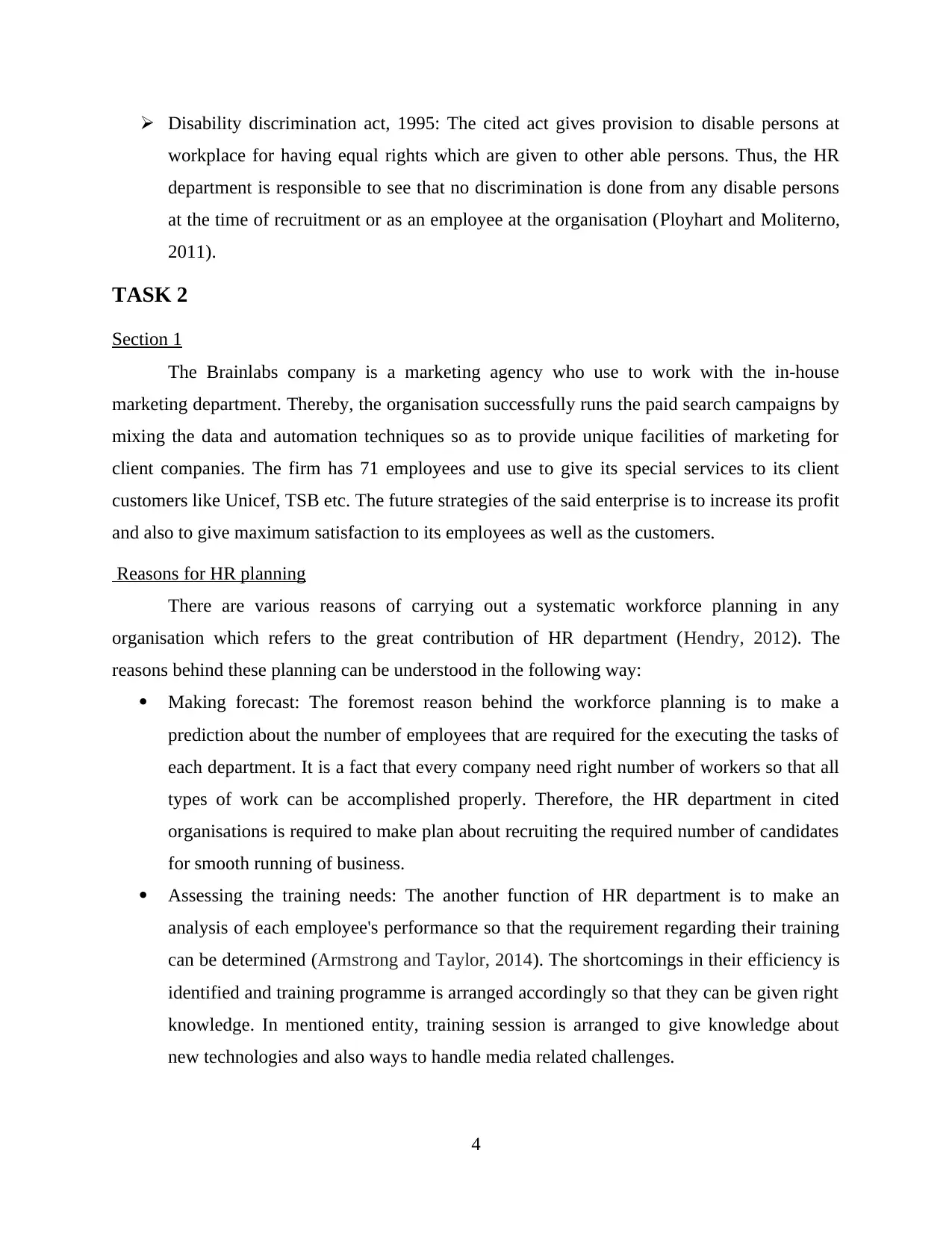
Disability discrimination act, 1995: The cited act gives provision to disable persons at
workplace for having equal rights which are given to other able persons. Thus, the HR
department is responsible to see that no discrimination is done from any disable persons
at the time of recruitment or as an employee at the organisation (Ployhart and Moliterno,
2011).
TASK 2
Section 1
The Brainlabs company is a marketing agency who use to work with the in-house
marketing department. Thereby, the organisation successfully runs the paid search campaigns by
mixing the data and automation techniques so as to provide unique facilities of marketing for
client companies. The firm has 71 employees and use to give its special services to its client
customers like Unicef, TSB etc. The future strategies of the said enterprise is to increase its profit
and also to give maximum satisfaction to its employees as well as the customers.
Reasons for HR planning
There are various reasons of carrying out a systematic workforce planning in any
organisation which refers to the great contribution of HR department (Hendry, 2012). The
reasons behind these planning can be understood in the following way:
Making forecast: The foremost reason behind the workforce planning is to make a
prediction about the number of employees that are required for the executing the tasks of
each department. It is a fact that every company need right number of workers so that all
types of work can be accomplished properly. Therefore, the HR department in cited
organisations is required to make plan about recruiting the required number of candidates
for smooth running of business.
Assessing the training needs: The another function of HR department is to make an
analysis of each employee's performance so that the requirement regarding their training
can be determined (Armstrong and Taylor, 2014). The shortcomings in their efficiency is
identified and training programme is arranged accordingly so that they can be given right
knowledge. In mentioned entity, training session is arranged to give knowledge about
new technologies and also ways to handle media related challenges.
4
workplace for having equal rights which are given to other able persons. Thus, the HR
department is responsible to see that no discrimination is done from any disable persons
at the time of recruitment or as an employee at the organisation (Ployhart and Moliterno,
2011).
TASK 2
Section 1
The Brainlabs company is a marketing agency who use to work with the in-house
marketing department. Thereby, the organisation successfully runs the paid search campaigns by
mixing the data and automation techniques so as to provide unique facilities of marketing for
client companies. The firm has 71 employees and use to give its special services to its client
customers like Unicef, TSB etc. The future strategies of the said enterprise is to increase its profit
and also to give maximum satisfaction to its employees as well as the customers.
Reasons for HR planning
There are various reasons of carrying out a systematic workforce planning in any
organisation which refers to the great contribution of HR department (Hendry, 2012). The
reasons behind these planning can be understood in the following way:
Making forecast: The foremost reason behind the workforce planning is to make a
prediction about the number of employees that are required for the executing the tasks of
each department. It is a fact that every company need right number of workers so that all
types of work can be accomplished properly. Therefore, the HR department in cited
organisations is required to make plan about recruiting the required number of candidates
for smooth running of business.
Assessing the training needs: The another function of HR department is to make an
analysis of each employee's performance so that the requirement regarding their training
can be determined (Armstrong and Taylor, 2014). The shortcomings in their efficiency is
identified and training programme is arranged accordingly so that they can be given right
knowledge. In mentioned entity, training session is arranged to give knowledge about
new technologies and also ways to handle media related challenges.
4
Paraphrase This Document
Need a fresh take? Get an instant paraphrase of this document with our AI Paraphraser
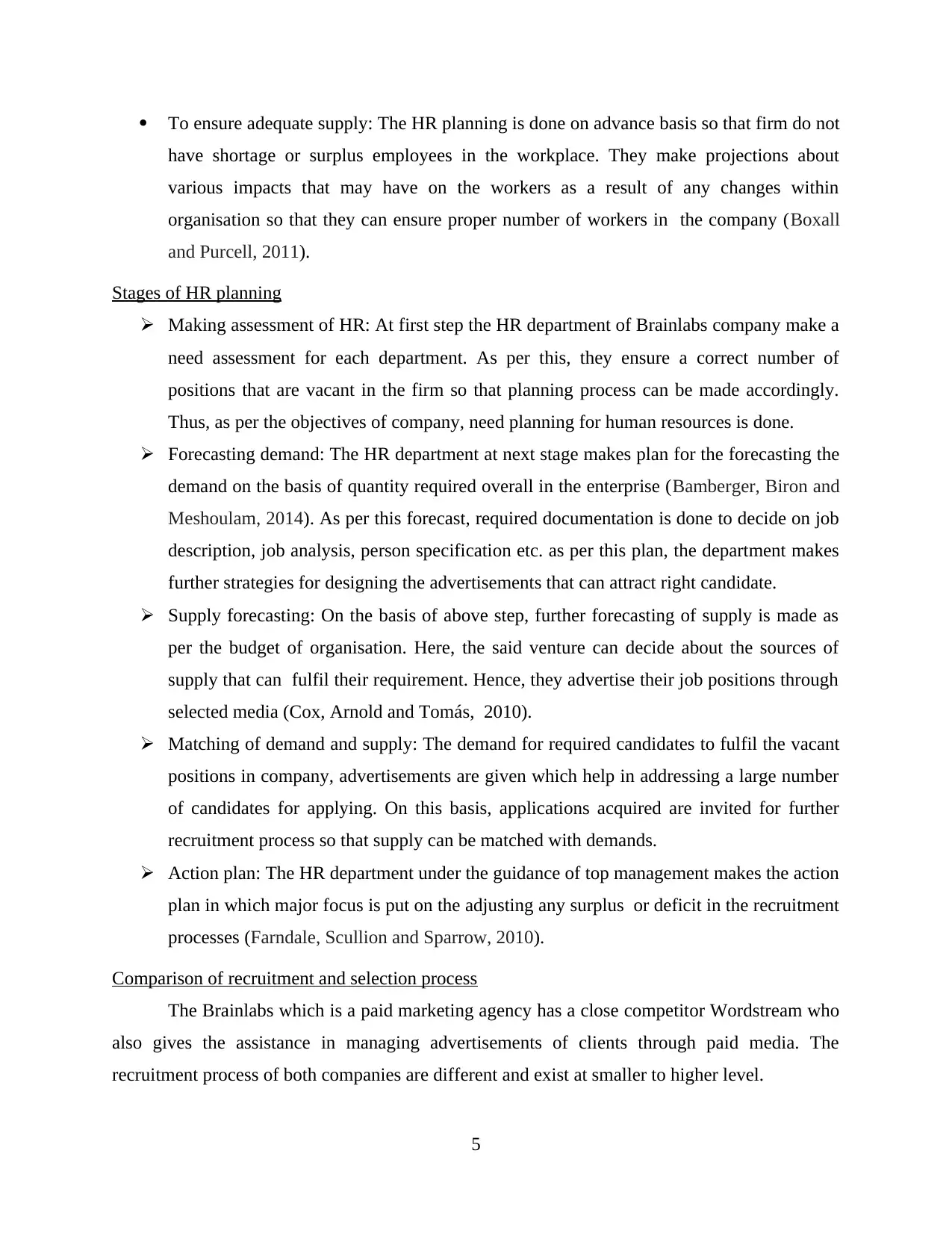
To ensure adequate supply: The HR planning is done on advance basis so that firm do not
have shortage or surplus employees in the workplace. They make projections about
various impacts that may have on the workers as a result of any changes within
organisation so that they can ensure proper number of workers in the company (Boxall
and Purcell, 2011).
Stages of HR planning
Making assessment of HR: At first step the HR department of Brainlabs company make a
need assessment for each department. As per this, they ensure a correct number of
positions that are vacant in the firm so that planning process can be made accordingly.
Thus, as per the objectives of company, need planning for human resources is done.
Forecasting demand: The HR department at next stage makes plan for the forecasting the
demand on the basis of quantity required overall in the enterprise (Bamberger, Biron and
Meshoulam, 2014). As per this forecast, required documentation is done to decide on job
description, job analysis, person specification etc. as per this plan, the department makes
further strategies for designing the advertisements that can attract right candidate.
Supply forecasting: On the basis of above step, further forecasting of supply is made as
per the budget of organisation. Here, the said venture can decide about the sources of
supply that can fulfil their requirement. Hence, they advertise their job positions through
selected media (Cox, Arnold and Tomás, 2010).
Matching of demand and supply: The demand for required candidates to fulfil the vacant
positions in company, advertisements are given which help in addressing a large number
of candidates for applying. On this basis, applications acquired are invited for further
recruitment process so that supply can be matched with demands.
Action plan: The HR department under the guidance of top management makes the action
plan in which major focus is put on the adjusting any surplus or deficit in the recruitment
processes (Farndale, Scullion and Sparrow, 2010).
Comparison of recruitment and selection process
The Brainlabs which is a paid marketing agency has a close competitor Wordstream who
also gives the assistance in managing advertisements of clients through paid media. The
recruitment process of both companies are different and exist at smaller to higher level.
5
have shortage or surplus employees in the workplace. They make projections about
various impacts that may have on the workers as a result of any changes within
organisation so that they can ensure proper number of workers in the company (Boxall
and Purcell, 2011).
Stages of HR planning
Making assessment of HR: At first step the HR department of Brainlabs company make a
need assessment for each department. As per this, they ensure a correct number of
positions that are vacant in the firm so that planning process can be made accordingly.
Thus, as per the objectives of company, need planning for human resources is done.
Forecasting demand: The HR department at next stage makes plan for the forecasting the
demand on the basis of quantity required overall in the enterprise (Bamberger, Biron and
Meshoulam, 2014). As per this forecast, required documentation is done to decide on job
description, job analysis, person specification etc. as per this plan, the department makes
further strategies for designing the advertisements that can attract right candidate.
Supply forecasting: On the basis of above step, further forecasting of supply is made as
per the budget of organisation. Here, the said venture can decide about the sources of
supply that can fulfil their requirement. Hence, they advertise their job positions through
selected media (Cox, Arnold and Tomás, 2010).
Matching of demand and supply: The demand for required candidates to fulfil the vacant
positions in company, advertisements are given which help in addressing a large number
of candidates for applying. On this basis, applications acquired are invited for further
recruitment process so that supply can be matched with demands.
Action plan: The HR department under the guidance of top management makes the action
plan in which major focus is put on the adjusting any surplus or deficit in the recruitment
processes (Farndale, Scullion and Sparrow, 2010).
Comparison of recruitment and selection process
The Brainlabs which is a paid marketing agency has a close competitor Wordstream who
also gives the assistance in managing advertisements of clients through paid media. The
recruitment process of both companies are different and exist at smaller to higher level.
5
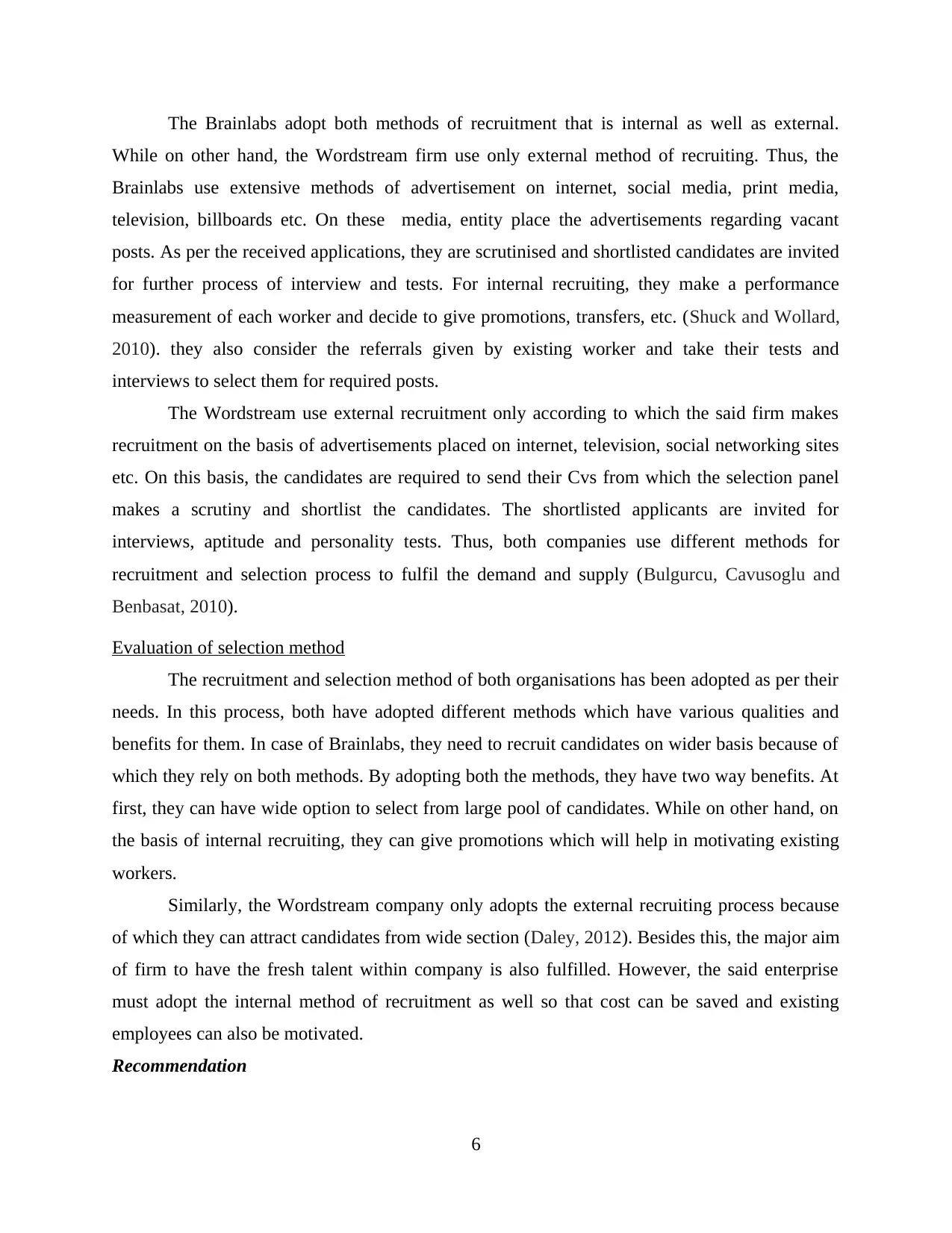
The Brainlabs adopt both methods of recruitment that is internal as well as external.
While on other hand, the Wordstream firm use only external method of recruiting. Thus, the
Brainlabs use extensive methods of advertisement on internet, social media, print media,
television, billboards etc. On these media, entity place the advertisements regarding vacant
posts. As per the received applications, they are scrutinised and shortlisted candidates are invited
for further process of interview and tests. For internal recruiting, they make a performance
measurement of each worker and decide to give promotions, transfers, etc. (Shuck and Wollard,
2010). they also consider the referrals given by existing worker and take their tests and
interviews to select them for required posts.
The Wordstream use external recruitment only according to which the said firm makes
recruitment on the basis of advertisements placed on internet, television, social networking sites
etc. On this basis, the candidates are required to send their Cvs from which the selection panel
makes a scrutiny and shortlist the candidates. The shortlisted applicants are invited for
interviews, aptitude and personality tests. Thus, both companies use different methods for
recruitment and selection process to fulfil the demand and supply (Bulgurcu, Cavusoglu and
Benbasat, 2010).
Evaluation of selection method
The recruitment and selection method of both organisations has been adopted as per their
needs. In this process, both have adopted different methods which have various qualities and
benefits for them. In case of Brainlabs, they need to recruit candidates on wider basis because of
which they rely on both methods. By adopting both the methods, they have two way benefits. At
first, they can have wide option to select from large pool of candidates. While on other hand, on
the basis of internal recruiting, they can give promotions which will help in motivating existing
workers.
Similarly, the Wordstream company only adopts the external recruiting process because
of which they can attract candidates from wide section (Daley, 2012). Besides this, the major aim
of firm to have the fresh talent within company is also fulfilled. However, the said enterprise
must adopt the internal method of recruitment as well so that cost can be saved and existing
employees can also be motivated.
Recommendation
6
While on other hand, the Wordstream firm use only external method of recruiting. Thus, the
Brainlabs use extensive methods of advertisement on internet, social media, print media,
television, billboards etc. On these media, entity place the advertisements regarding vacant
posts. As per the received applications, they are scrutinised and shortlisted candidates are invited
for further process of interview and tests. For internal recruiting, they make a performance
measurement of each worker and decide to give promotions, transfers, etc. (Shuck and Wollard,
2010). they also consider the referrals given by existing worker and take their tests and
interviews to select them for required posts.
The Wordstream use external recruitment only according to which the said firm makes
recruitment on the basis of advertisements placed on internet, television, social networking sites
etc. On this basis, the candidates are required to send their Cvs from which the selection panel
makes a scrutiny and shortlist the candidates. The shortlisted applicants are invited for
interviews, aptitude and personality tests. Thus, both companies use different methods for
recruitment and selection process to fulfil the demand and supply (Bulgurcu, Cavusoglu and
Benbasat, 2010).
Evaluation of selection method
The recruitment and selection method of both organisations has been adopted as per their
needs. In this process, both have adopted different methods which have various qualities and
benefits for them. In case of Brainlabs, they need to recruit candidates on wider basis because of
which they rely on both methods. By adopting both the methods, they have two way benefits. At
first, they can have wide option to select from large pool of candidates. While on other hand, on
the basis of internal recruiting, they can give promotions which will help in motivating existing
workers.
Similarly, the Wordstream company only adopts the external recruiting process because
of which they can attract candidates from wide section (Daley, 2012). Besides this, the major aim
of firm to have the fresh talent within company is also fulfilled. However, the said enterprise
must adopt the internal method of recruitment as well so that cost can be saved and existing
employees can also be motivated.
Recommendation
6
⊘ This is a preview!⊘
Do you want full access?
Subscribe today to unlock all pages.

Trusted by 1+ million students worldwide
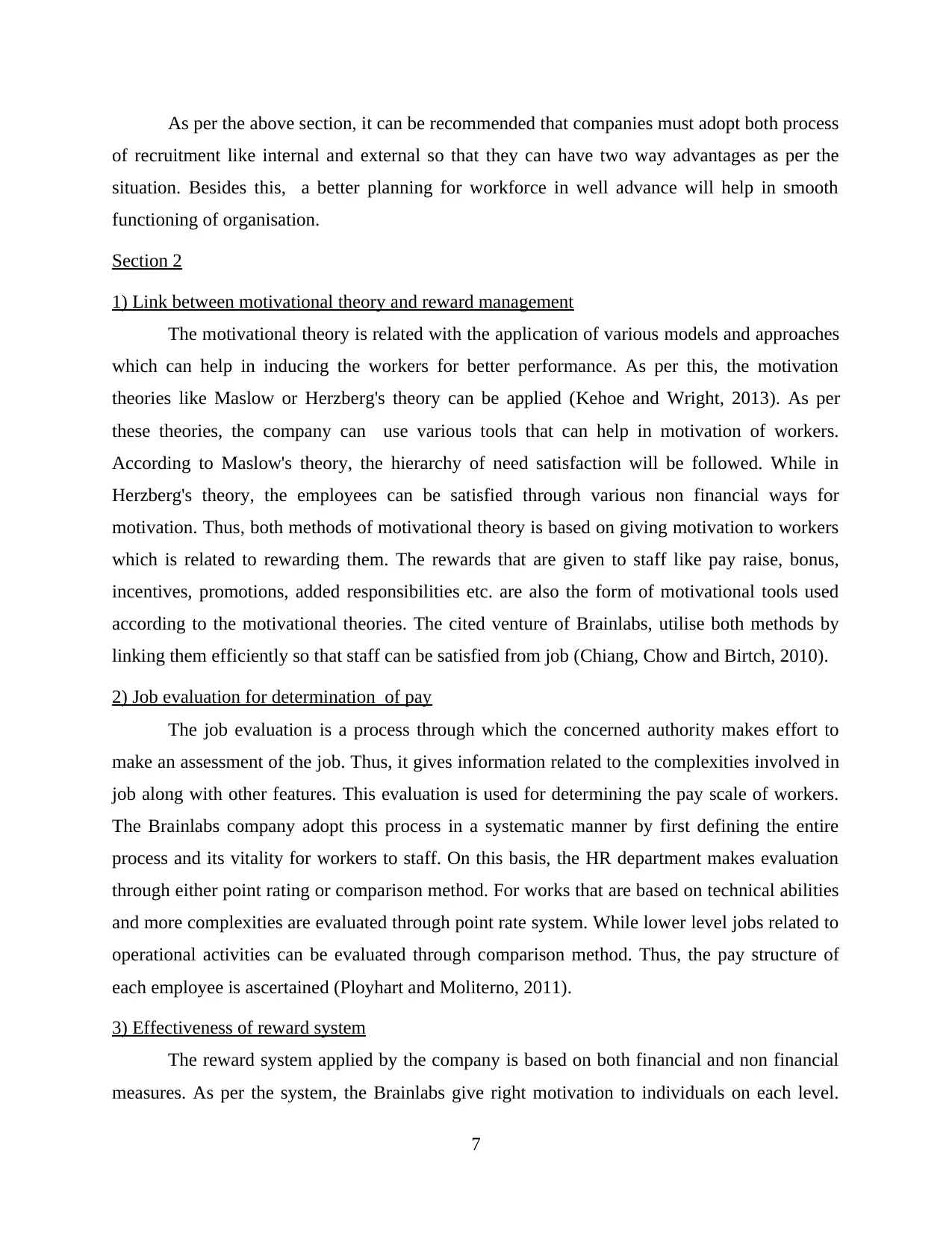
As per the above section, it can be recommended that companies must adopt both process
of recruitment like internal and external so that they can have two way advantages as per the
situation. Besides this, a better planning for workforce in well advance will help in smooth
functioning of organisation.
Section 2
1) Link between motivational theory and reward management
The motivational theory is related with the application of various models and approaches
which can help in inducing the workers for better performance. As per this, the motivation
theories like Maslow or Herzberg's theory can be applied (Kehoe and Wright, 2013). As per
these theories, the company can use various tools that can help in motivation of workers.
According to Maslow's theory, the hierarchy of need satisfaction will be followed. While in
Herzberg's theory, the employees can be satisfied through various non financial ways for
motivation. Thus, both methods of motivational theory is based on giving motivation to workers
which is related to rewarding them. The rewards that are given to staff like pay raise, bonus,
incentives, promotions, added responsibilities etc. are also the form of motivational tools used
according to the motivational theories. The cited venture of Brainlabs, utilise both methods by
linking them efficiently so that staff can be satisfied from job (Chiang, Chow and Birtch, 2010).
2) Job evaluation for determination of pay
The job evaluation is a process through which the concerned authority makes effort to
make an assessment of the job. Thus, it gives information related to the complexities involved in
job along with other features. This evaluation is used for determining the pay scale of workers.
The Brainlabs company adopt this process in a systematic manner by first defining the entire
process and its vitality for workers to staff. On this basis, the HR department makes evaluation
through either point rating or comparison method. For works that are based on technical abilities
and more complexities are evaluated through point rate system. While lower level jobs related to
operational activities can be evaluated through comparison method. Thus, the pay structure of
each employee is ascertained (Ployhart and Moliterno, 2011).
3) Effectiveness of reward system
The reward system applied by the company is based on both financial and non financial
measures. As per the system, the Brainlabs give right motivation to individuals on each level.
7
of recruitment like internal and external so that they can have two way advantages as per the
situation. Besides this, a better planning for workforce in well advance will help in smooth
functioning of organisation.
Section 2
1) Link between motivational theory and reward management
The motivational theory is related with the application of various models and approaches
which can help in inducing the workers for better performance. As per this, the motivation
theories like Maslow or Herzberg's theory can be applied (Kehoe and Wright, 2013). As per
these theories, the company can use various tools that can help in motivation of workers.
According to Maslow's theory, the hierarchy of need satisfaction will be followed. While in
Herzberg's theory, the employees can be satisfied through various non financial ways for
motivation. Thus, both methods of motivational theory is based on giving motivation to workers
which is related to rewarding them. The rewards that are given to staff like pay raise, bonus,
incentives, promotions, added responsibilities etc. are also the form of motivational tools used
according to the motivational theories. The cited venture of Brainlabs, utilise both methods by
linking them efficiently so that staff can be satisfied from job (Chiang, Chow and Birtch, 2010).
2) Job evaluation for determination of pay
The job evaluation is a process through which the concerned authority makes effort to
make an assessment of the job. Thus, it gives information related to the complexities involved in
job along with other features. This evaluation is used for determining the pay scale of workers.
The Brainlabs company adopt this process in a systematic manner by first defining the entire
process and its vitality for workers to staff. On this basis, the HR department makes evaluation
through either point rating or comparison method. For works that are based on technical abilities
and more complexities are evaluated through point rate system. While lower level jobs related to
operational activities can be evaluated through comparison method. Thus, the pay structure of
each employee is ascertained (Ployhart and Moliterno, 2011).
3) Effectiveness of reward system
The reward system applied by the company is based on both financial and non financial
measures. As per the system, the Brainlabs give right motivation to individuals on each level.
7
Paraphrase This Document
Need a fresh take? Get an instant paraphrase of this document with our AI Paraphraser

The company gives lower level workers financial rewards like pay raise, incentives, bonus etc. to
increase motivations as well as to induce job satisfaction. While on other hand, the stated firm
gives non financial motivation to higher level managers like promotions, recognition, added
responsibilities etc. After giving motivation through different tools, the company observes the
changes in worker's efficiency so that it can be decided that the motivation tools have helped in
right way (Ployhart and Moliterno, 2011).
4) Monitoring employees performance
Direct observation: This method includes direct observing on a random basis at the time
of working at job. This gives knowledge to the managers of quoted enterprise about the
performance of the particular worker. Thus, evaluation can be made on the performance. Performance standard: The said enterprise use the method of fixing a standard level for
each job which the workers have to attain at a specific time. Thus, the employee who
fulfils the need and match his task as per the standard is given rewards (Nadiri and
Tanova, 2010). While, the worker who has not achieved the set standard is observed and
given training to improve the efficiency.
Recommendation
The firm can employ various other methods of motivation like get together, giving non
monetary rewards to lower level workers along financial incentives. Besides this, the entity can
use other methods of performance monitoring like 360 degree appraisal where the feedback can
be attained from seniors and colleagues about work.
Section 3
1) Reasons of termination
The termination can be on two basis which is either voluntary or involuntary. In the
situation of voluntary retirement, the workers can leave the organisation by resigning in search of
better opportunities, growth and by retirement (Soon and Baines, 2012). In Brainlabs, the
percentage of voluntary leavers is very less that is 10%. similarly, the involuntary termination
can be based on retrenchment, dissatisfaction of employer from staff, unacceptable behaviour of
an individual etc. thus, the firms can have both types of termination.
2) Exit process
In Brainlabs, the exit process takes place in following way:
8
increase motivations as well as to induce job satisfaction. While on other hand, the stated firm
gives non financial motivation to higher level managers like promotions, recognition, added
responsibilities etc. After giving motivation through different tools, the company observes the
changes in worker's efficiency so that it can be decided that the motivation tools have helped in
right way (Ployhart and Moliterno, 2011).
4) Monitoring employees performance
Direct observation: This method includes direct observing on a random basis at the time
of working at job. This gives knowledge to the managers of quoted enterprise about the
performance of the particular worker. Thus, evaluation can be made on the performance. Performance standard: The said enterprise use the method of fixing a standard level for
each job which the workers have to attain at a specific time. Thus, the employee who
fulfils the need and match his task as per the standard is given rewards (Nadiri and
Tanova, 2010). While, the worker who has not achieved the set standard is observed and
given training to improve the efficiency.
Recommendation
The firm can employ various other methods of motivation like get together, giving non
monetary rewards to lower level workers along financial incentives. Besides this, the entity can
use other methods of performance monitoring like 360 degree appraisal where the feedback can
be attained from seniors and colleagues about work.
Section 3
1) Reasons of termination
The termination can be on two basis which is either voluntary or involuntary. In the
situation of voluntary retirement, the workers can leave the organisation by resigning in search of
better opportunities, growth and by retirement (Soon and Baines, 2012). In Brainlabs, the
percentage of voluntary leavers is very less that is 10%. similarly, the involuntary termination
can be based on retrenchment, dissatisfaction of employer from staff, unacceptable behaviour of
an individual etc. thus, the firms can have both types of termination.
2) Exit process
In Brainlabs, the exit process takes place in following way:
8

1. Resignation letter of employee is handed over to immediate manager.
2. This resigns communication is done with HR department.
3. The leaving employee submits important log in ID, password and other belongings of
company.
4. The exit interview form is filled by the leaving worker.
Similarly, the exit process of Wordstream differs in below mentioned way:
1. The personnel manager gives information to HR department about the resign of worker.
2. Forwarded resignation to HR is processed before which the employee is called for
conversation regarding reasons for leaving.
3. The information regarding the notice period and similar significant information is passed
to worker.
4. The exit interview is conducted at the end.
3) Impact of legislation and regulation
The joining and exit of an employee, both need various legal formalities and
documentations (Fulton and et.al., 2011). While joining of a candidate, it is required for him/ her
to sign some legal documents and sign the employment forms. Besides this, it is required from
the new joined employee to submit documents and Ids as well. Similarly, at the time of
cessation, it is necessary for the employer to give prior notice to worker of at least one month so
that the worker can prepare himself for this. In addition to this, if the cessation is due to some
fault of worker, then he should be given enough opportunity for giving the clarification. At the
end, the exit interview must be filled by the leaving worker (Clark and et.al., 2011).
Recommendation
It can be recommended that the Brainlabs must make strategies through which the
workers can be retained. They can be given opportunities for developing so that they do not have
to leave the work in search of better employment.
CONCLUSION
The report has shown the differences between personnel and HRM and discussed the
importance of HRM over personnel management in companies. The selected organisation for the
discussion is Brainlabs which is a marketing agency. Apart from this, the recruitment process has
been talked about which is followed in the said organisation. Further, motivational techniques
9
2. This resigns communication is done with HR department.
3. The leaving employee submits important log in ID, password and other belongings of
company.
4. The exit interview form is filled by the leaving worker.
Similarly, the exit process of Wordstream differs in below mentioned way:
1. The personnel manager gives information to HR department about the resign of worker.
2. Forwarded resignation to HR is processed before which the employee is called for
conversation regarding reasons for leaving.
3. The information regarding the notice period and similar significant information is passed
to worker.
4. The exit interview is conducted at the end.
3) Impact of legislation and regulation
The joining and exit of an employee, both need various legal formalities and
documentations (Fulton and et.al., 2011). While joining of a candidate, it is required for him/ her
to sign some legal documents and sign the employment forms. Besides this, it is required from
the new joined employee to submit documents and Ids as well. Similarly, at the time of
cessation, it is necessary for the employer to give prior notice to worker of at least one month so
that the worker can prepare himself for this. In addition to this, if the cessation is due to some
fault of worker, then he should be given enough opportunity for giving the clarification. At the
end, the exit interview must be filled by the leaving worker (Clark and et.al., 2011).
Recommendation
It can be recommended that the Brainlabs must make strategies through which the
workers can be retained. They can be given opportunities for developing so that they do not have
to leave the work in search of better employment.
CONCLUSION
The report has shown the differences between personnel and HRM and discussed the
importance of HRM over personnel management in companies. The selected organisation for the
discussion is Brainlabs which is a marketing agency. Apart from this, the recruitment process has
been talked about which is followed in the said organisation. Further, motivational techniques
9
⊘ This is a preview!⊘
Do you want full access?
Subscribe today to unlock all pages.

Trusted by 1+ million students worldwide
1 out of 14
Related Documents
Your All-in-One AI-Powered Toolkit for Academic Success.
+13062052269
info@desklib.com
Available 24*7 on WhatsApp / Email
![[object Object]](/_next/static/media/star-bottom.7253800d.svg)
Unlock your academic potential
Copyright © 2020–2025 A2Z Services. All Rights Reserved. Developed and managed by ZUCOL.





